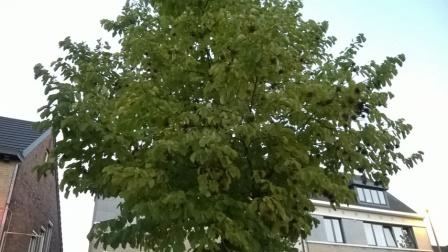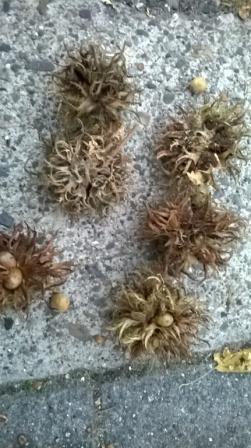Our food consists of a small portion of wild harvested food (mushrooms, nuts, berries, game, fish, herbs), domesticated and bred cattle and mainly cultivated crops. They need plenty of space and fertile soil. Which in cities is largely occupied by concrete.
Inventive people sought and found opportunities to let also city people harvest (a (small) part of) their own food.
Flower box becomes vegetable tray in the edible city
In the town of Todmorden in West Yorkshire, England (about 17,000 inhabitants) Pam Warhurst and Mary Clear started in 2008 with ’Incredible Edible'. In beds and planters, on the platform,... they planted rhubarb, strawberries and vegetables. The project was very successful and received support from the local government to plant 500 fruit trees.
By 2018 they want provide themselves in all food for the city.
Everything is maintained by volunteers. Anyone can harvest them and take them home. By analogy with software, the principle is also called open source food.
The intention is to make people aware to buy food locally and in season and grow it themselves in their garden, on the balcony and in planters. Growing our food on the other side of the world and transport it to here has a high cost. Local initiatives involving the population have already been successfully in Belgium and England.
http://www.incredible-edible-todmorden.co.uk/home
(In relation to the security of the site, the links are not active, you can google them, if they are https they will be activated again later.)
Harvest public fruit
Where in the wild to find fruit (in the Netherlands), nuts or vegetables you see on the Wild Pick Pointer. It's a handy Google Map which brings with your help, all the public fruit trees and bushes, nut trees and stray cucumber plants in map. You can search by picking spots, by type, seasonally...
The Working Group ’Harvesting without seeding’ (from Slow Food Netherlands) is working on it with references to their Wild Pick Wiki.
http://wildplukwijzer.nl/blog/overdewildplukwijzer/
http://oogstenzonderzaaien.nl/
 Corylus colurna, Turkish - or hazel tree in species that is often planted in cities, with edible hazelnuts in decorative, whimsical fused fruit shells.
Corylus colurna, Turkish - or hazel tree in species that is often planted in cities, with edible hazelnuts in decorative, whimsical fused fruit shells.
Guerrilla gardening is trying to get more greenery in the city by making with volunteers (possibly illegally) gardens (like e.g. The Brussels Farmers).
http://www.guerrillagardening.be/
https://guerrillagardeners.groenlinks.nl/
 Stealthy grafting
Stealthy grafting
For different reasons, but also to counteract fast food Tara Hui started around 2010 in San Francisco with ’guerrilla grafting', the clandestine grafting of ornamental trees with fruit-bearing varieties. This form of gardening gives disobedient people more access to fresh fruit and brings them easier in contact with gardening.
For the authorities fruit trees were mainly a source of nuisance.
When a foundation planted trees (Prunus) in her street she started grafting fruiting plum branches from her garden on the trees in the street. She received acclaim from fans, and a movement was born. There is now a database of all fruit trees tracked and controlled to provide people from around to nurse these trees. (See <Grafting> and <Inoculate>)
If you know lost corners that are not sprayed dead or are constantly mowed, you also can e.g. stab walnuts or hazelnuts into the ground. Mother Nature does the rest. Also cores, acorns, chestnuts and cherry pits let themselves easily spread in this way.
You also can raise them in a basin a few years, and then transplant them. If you have a nice crunch next to it, and a card with a Latin name attached, great chances that they will be left alone. Even complete avenues.
http://www.milieudefensie.nl/publicaties/down-to-earth-magazine/artikelen/appels-voor-iedereen
Also at your own place you can do something
In’ window farming’ you use daylight coming through your window to the windowsill and in hanging pots and bottles to grow some vegetables (lettuce, radish, onion..) and herbs (chives, parsley..).
On a balcony or courtyard you can make besides flowers pots also trays for e.g. tomatoes, and also work in height with a ’vertical garden’ of suspended baskets and bins. You can also apply a narrow strip of soil against a wall protected by a waterproof film (to avoid moisture in the wall!). Attach (to the wall) a grid (or old pallets) at 10 to 20 cm from the wall. Herein you can make your planting holes to grow vegetables.
In cities, land is expensive. More and more Rooftop farms are built for Urban (Rooftop) Farming. Chicago has 359 agricultural roofs. The roof of McCormick Place, the largest convention center in the United States, has become a real farm that annually yields about 4.5 tonnes of fruit and vegetable. This Windy City Harvest project employs ex-offenders.
The biggest Rooftop farm is Brooklyn Grange in New York City: an acre, spread over several rooftops. Annually, about 18 tonnes of organic fruits and vegetables are harvested.
South Park office in Amsterdam has on ten meters height 3,000 square meters with more than 60 kinds of vegetables, herbs and berries. The driving force, real estate entrepreneur and concept developer Jan Huijbregts and gardener Douwe are assisted by unemployed, 40,000 bees provide honey and six chickens recycle kitchen waste to eggs.
The production is processed in the canteens of the South Park complex. Espresso ’Confiteria Belgrano’ is largely self-sufficient with varied ’top dishes’.
Roof (kitchen) gardens are buffering plenty of water and protect against heat and cold surges. For the construction is desirable: a root barrier roofing, low decay (< 9%), solid timbers for sufficient additional roof load, higher eaves (or secure enclosure), water, accessibility.
Take into account wind loads for high planting! The substrate thickness largely determines which plants are able to develop. From 70 to 120 mm is suitable for herbs like marjoram, thyme rosemary, lavender, lamb's lettuce and strawberries. Substrate thickness of 130 to 250 mm can be used for vegetables such as lettuce, tomatoes, carrots, beans, berry bushes. And 260 to 400 mm can also bear fruiting shrubs and small trees.
Advantage of roof gardens: little affected by moles.
On the outskirts of the city you often find nearby gardens or allotments. You can rent a (little) part to cultivate.
Transition Towns, Transition Network Vlaanderen and similar have also activities and information that you may find helpful. Repair Café (teach you to restore your own stuff under expert supervision) actually belongs to this concept. As wel as tool lending (Stuff & Sun: (share stuff) spullendelen.nl; (my cloths) mijnkleren.nl; (dare to ask) durftevragen.com; zilok.com; (hiring from neighbors) hurenvanburen.nl; (switch garden) ruiltuin.nl; peerby.com).
Meaningful initiatives if you know that a drill is used 12 to 13 minutes per year. While we actually do not need the drill, but a hole.
A car costs a small fortune each year, and is 23h/day not used!
Find ecological communities and habitats on
http://www.omslag.nl/wonen/ecodorpen.html#gerealiseerd
Harvesting outside the city (transition)
You can anywhere in the country buy directly from the producer. Signs along the way are pointing you to what is For Sale: strawberries, (free range) eggs, honey, (new) potatoes, cherry fruit and others. Sometimes you can go pick yourself for a small amount.
Previously we picked ’for half’. The harvest was divided between picker and owner.
People with fruit trees, especially tall ones (trees), are often happy if someone wants to pick the fruit. Because they can (or dare) no longer, or because they simply have too many. This often applies to St. John's Berries and rhubarb.
